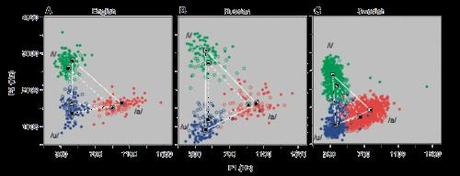Speech recognition software is designed to understand the infinite complexities of how we talk. Read up on how Motherese, a linguistic phenomenon also known as “baby talk,” expands the limits of our speech.
Did you know that there is a scientific term for that over the top way we talk to babies? Motherese is the proper linguistic term that describes the type of speech used by adults when speaking to infants, and is typically characterized by slow repetition and hyper-articulation, meant to help younger children learn language skills. This pattern of talking is also correlated with higher pitches, simpler sentences, and warmer tones, turning speech into an almost theatrical (and adorable) display.

We speak differently to babies than we do to waiters in restaurants - but exactly how differently do we talk? The image above shows the space formed by articulating vowels in English, Russian, and Swedish, respectively. Can you guess which vowel triangles represent Motherese in each language? Since Motherese is more explanatory, the elongated way the vowels are pronounced expands the acoustic space in the vowel triangles. The more the vowels are stretched, the clearer the speech is, since babies need clarity in order to learn how to detect subtle language differences. Therefore, the outer triangles across all three languages are Motherese. Motherese is universal across languages, and is always larger than the vowel space that represents modern language. Who knew that baby talk made so much sense?
Image source: Kuhl, Patricia K. August 1997. Cross-Language Analysis of Phonetic Units in Language Addressed to Infants. Science Magazine, Vol. 277,Page 2. DOI: 0.1126/science.277.5326.684
(Source: sciencemag.org)
